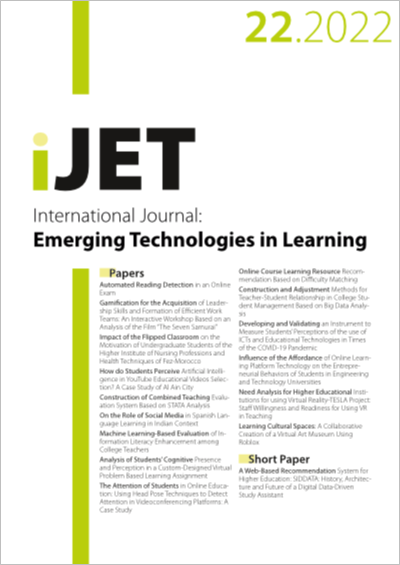The Attention of Students in Online Education
Using Head Pose Techniques to Detect Attention in Videoconferencing Platforms: A Case Study
DOI:
https://doi.org/10.3991/ijet.v17i22.34241Keywords:
attention level, head detection, intelligent systems, computer vision, online education, videoconferencing platformsAbstract
The level of attention of students who receive classes through videoconferencing platforms is troubling. Different throughout an entire lecture, the instructor can perceive the participants' behavior, while in an online class, it is difficult to determine if they are attentive to the instructions given. An innovative method that helps solve this problem is the use of computer vision algorithms, with methods such as face detection, facial landmarks, face recognition, and head pose detection based on deep learning networks. In this paper, a neural network was trained using facial landmarks to estimate head position and thus attention levels. The model was applied in five classes using different videoconferencing platforms in the Intelligent Systems subject of a private university in Ecuador. Some limitations, such as lighting and video quality, affected the level of accuracy. The number of registered participants was 12, of which between 30% and 80% attended. The maximum level of attention detected was 91.9%, while the minimum level was 86.6%. This case study proves that the head position detection function employed by many videoconferencing platforms is a useful parameter that aids the instructor in this type of context.
Downloads
Published
2022-11-28
How to Cite
Barba-Guaman, L. R., & Valdiviezo-Diaz, P. (2022). The Attention of Students in Online Education: Using Head Pose Techniques to Detect Attention in Videoconferencing Platforms: A Case Study. International Journal of Emerging Technologies in Learning (iJET), 17(22), pp. 144–155. https://doi.org/10.3991/ijet.v17i22.34241
Issue
Section
Papers
License
Copyright (c) 2022 Luis Barba-Guaman, Priscila Valdiviezo-Diaz

This work is licensed under a Creative Commons Attribution 4.0 International License.


